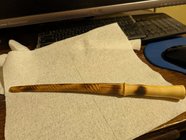Legend has it that this was used in one of the many battles with Voldemort so it has seen a lot of strong magic.
That's one thing to say about it.... The other is I was just messing around and the spiraling was not intentional. What was I doing wrong to cause it? I was trying to get a smooth surface but that didn't work out but I liked the look of it so I stopped there without completing the project and that's why it's proportions are not right.
That's one thing to say about it.... The other is I was just messing around and the spiraling was not intentional. What was I doing wrong to cause it? I was trying to get a smooth surface but that didn't work out but I liked the look of it so I stopped there without completing the project and that's why it's proportions are not right.

